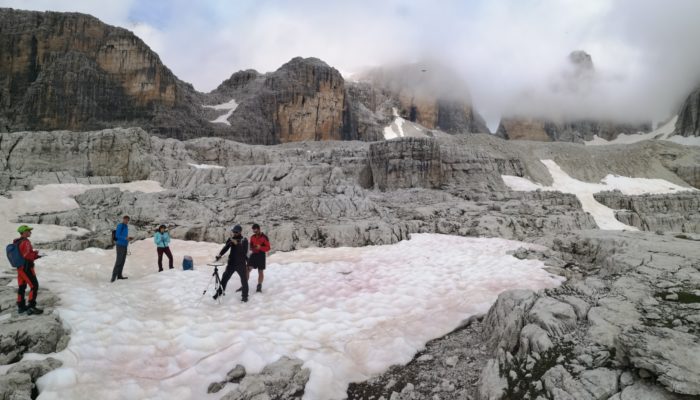We are used to think of algae as marine or lacustrine organisms, but they are actually able to thrive also on the cryosphere. In a previous post, we learnt how snow algae live and reproduce on snow. Now we will explore how and why scientists study snow algae, and how social media can be used for identifying new study areas. Snow algae in the Alps Snow algae in the Alps have been overlooked or conf ...[Read More]
If you didn't find what you was looking for try searching again.
Cryospheric Sciences
Women of Cryo IV: Virginia ‘Ginny’ Fiennes (1947 – 2004)
Women make up 50.8% of the worlds population, yet fewer than 30% of the world’s researchers are women. Of this percentage, BAME (Black Asia and Minority Ethnic) comprise around 5%, with less than 1% represented in geoscience faculty positions. The divide between women in the population and women in STEM needs to be addressed. Through a series of blog posts we hope to raise the voice of women in th ...[Read More]
Cryospheric Sciences
Let’s go to School of Sustainability!
Next generations will not only see impacts of climate change first-hand, but they will also deal with the associated societal implications. Implementing climate solutions and orienting themselves in a growing, green job market need cutting-edge knowledge, which is often hard to get through the ordinary, high-school syllabus. As early-career cryo-scientists (Federica is a PhD student in glacial geo ...[Read More]
Cryospheric Sciences
Cryo-adventures – Undertaking Cryo-Fieldwork in a Global Pandemic!
Have you ever wondered what undertaking cryo-fieldwork in a glacial environment typically involves? Well, what about undertaking cryo-fieldwork in a glacial environment during a global pandemic?! Read on to find out all about the challenges I faced on my recent trip to Iceland in July 2021… Fieldwork Preparation As this previous blog post highlights, undertaking cryo-fieldwork requires a significa ...[Read More]
Cryospheric Sciences
Did you know about Artificial Glaciers?
There are several ways that we can classify glaciers. We can look at their shape, their size, their type of terminus, and many other features. A new characteristic has recently been gaining in popularity: artificiality. Yes, we now have a few artificial glaciers! Have you ever heard about them? They are glaciers whose behavior is directly influenced by human interventions in order to improve their ...[Read More]
Cryospheric Sciences
Did you know about the weathering crust? Five things you never knew about glacier surfaces
To the untrained eye, the melting surface of glaciers and ice sheets can look a little boring. It’s bright in some places, dark in others, and there are lots of things to fall over and (hopefully not) get your feet wet in. However, a huge range of processes are occurring both upon and just underneath the ice surface, in a 50-ish cm thick layer of ice called the weathering crust (or the “crust” for ...[Read More]
Cryospheric Sciences
Re-discovering the British North Greenland Expedition 1952-54
How did we (nearly) all forget about, or simply overlook, a large-scale two-year long mid-20th Century scientific expedition to the northern Greenland Ice Sheet? Particularly an expedition that kick-started some significant glaciological and geophysical careers, developed large-scale polar logistical capabilities, traversed the ice sheet, acquired some novel and critical data, and asked some big r ...[Read More]
Cryospheric Sciences
Cryo Careers: Should I stay, or should I go? Non-linear career paths
Nature is chaotic and random. Non-linear processes take place in our oceans, atmosphere and ice. No two snowflakes are the same, so why would two careers be the same? In this week’s blog, we highlight a number of scientists who took non-linear routes in their careers and give you some advice if you are considering a career change. Why do we need to highlight different career paths? From a young ag ...[Read More]
Cryospheric Sciences
Women of Cryo III: Women monitoring the Peruvian glaciers
The ruins of a hidden majestic city as Machupicchu in Peru immediately call for our attention. However, there are far more beautiful attractions found hidden amongst the landscape, such as the glaciers, high mountains or the cultural heritage in the area. In South America, glacial bodies are geographically restricted to the Andes, the mountain range that runs across the continent from the tropics ...[Read More]
Cryospheric Sciences
Cryo tips to make the most of vEGU21
Similar to last year, this year’s annual general assembly is fully virtual. But unlike last year, the in-person experience is back! There are short courses, networking events and a website which looks just like the real Vienna Conference Centre. So go and buy yourself a Viennese Sachertorte, brew a batch of coffee and take 5 minutes to look at our top recommendations for vEGU21. vEGU21 – wha ...[Read More]









